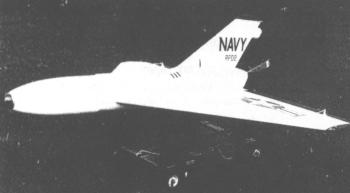Applied Physics Lab RPD-2 Paradel
The RPD-2 Paradel mini-RPV was built for the U.S. Naval Surface Weapons Center by the Applied Physics Laboratory of the Johns Hopkins University. It first flew in June 1975.
The RPD-2 was launched from a catapult and powered by a single McCulloch MC-101A piston engine. For recovery, a parachute system was installed, and airbags stowed in the wings softened the ground impact. The drone's equipment included a passive radar augmentation device in the nose and a Luneberg lens in a tailfin fairing.
 |
| Photo: via Jane's |
| RPD-2 Paradel |
Four RPD-2s were built, and they were used by the Navy to evaluate new ship-board fire control systems and gun ranging radars. This test program ended around 1979/80.
Specifications
Data for RPD-2 Paradel:
| Length | 2.06 m (6 ft 9 in) |
| Wingspan | 2.03 m (6 ft 8 in) |
| Height | 0.72 m (2 ft 4.25 in) |
| Weight | 46 kg (101 lb) |
| Speed | 258 km/h (173 mph) |
| Ceiling | 5500 m (18000 ft) |
| Endurance | 2.5 h |
| Propulsion | McCulloch MC-101A piston engine; 7.5 kW (10 hp) |
Main Sources
[1] Kenneth Munson: "World Unmanned Aircraft", Jane's, 1988
Back to Directory of U.S. Military Rockets and Missiles, Appendix 4
Last Updated: 5 May 2004